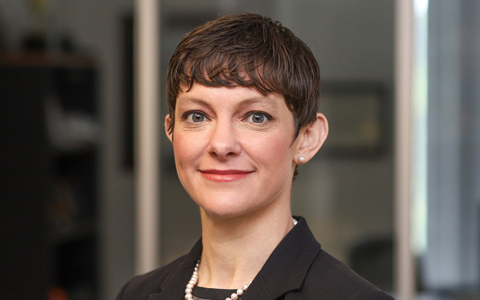
Aviation Lead Kate Lindekugel provides sustainability and resilience planning, environmental compliance, and consulting services to aviation clients. In this role, she frequently helps VHB clients understand how new mobility modes will impact their businesses and communities, as well as the aviation industry. We spoke with Kate to find out more about the fascinating ways new mobility is changing the aviation industry and improving mobility and access.
VHB: How do you define new mobility as it relates to transportation and, specifically, aviation?
Kate: New mobility encompasses a range of innovative, technology-enabled solutions for moving people and goods more efficiently and sustainability while also expanding the capacity and accessibility of transportation networks. Electric, connected, and autonomous vehicle technologies in surface transportation are becoming more commonplace, but in the aviation sector, innovative technologies are paving the way for Advanced Air Mobility (AAM), which includes everything from small, versatile aircraft like drones to flying electric vehicles that can carry multiple passengers or substantial amounts of cargo. Dynamic breakthroughs in innovation have begun within aviation new mobility markets and with AAM technology, which has made significant positive impacts on communities, local and regional economies, and the environment.
VHB: What are some possible benefits from AAM, including using electric vertical takeoff and landing (eVTOL) aircraft from vertiports?
Kate: While many potential benefits from full-scale implementation are still in the future, significant advances have been made, and a variety of AAM vehicles are in use today with tangible benefits felt by the communities they serve. Eventually, AAM could help alleviate traffic congestion in major cities where road expansion isn’t feasible or practical for reasons like physical or geographic constraints, the financial burden involved, or negative impacts to affected communities. Vertiports for eVTOL aircraft occupy very little space—they can be the size of a helicopter pad or parking lot and can be far less expensive to build than roads or bridges. Vertiports can also be constructed on top of pre-existing buildings with eVTOL aircraft using the building’s existing electricity supply instead of fossil fuels. These unique features mean we can use air space to dramatically improve mobility and access to goods and services for people in densely urban areas or within economically burdened communities.
Where I live in North Carolina, we have a local business that operates drone aircraft from a CVS parking lot to deliver food and medicine right to my front yard. This is a pretty cool innovation, but drone deliveries can also help low income and historically disadvantaged communities within “food deserts” where access to fresh foods and produce is very limited. By using AAM aircraft, we can deliver essential supplies to underserved communities, which will be a game changer for many families currently burdened by food insecurity.
VHB: You’ve witnessed first-hand the positive benefits of AAM on storm-impacted communities. Can you share a bit about your experience?
Kate: I was born in Western North Carolina, but moved to Charleston, South Carolina, when I was very young. Unfortunately, both areas have been impacted by extreme weather, including last year’s Hurricane Helene. However, Helene recovery efforts were augmented with AAM aircraft to bring substantial relief faster than was possible just five years ago. This made a huge difference.
When I was eight years old, Hurricane Hugo, a Category 5 storm, hit my hometown of Charleston. We were without potable water or electricity for several months. While only 13 South Carolinians died in the storm, some 56,000 people were left homeless after the storm, and many more people died in the months after from exposure, starvation, or lack of medical care. I think about these childhood hardships now and how AAM technology would have made such a huge difference. With AAM aircraft, we can now get fresh drinking water, food, and first aid into places where it’s not yet safe or accessible for first responders, and in doing so, we can save lives—of both victims and rescue teams.
VHB: What does the future hold for advanced air mobility?
Kate: As with all new emerging technologies, regulations and requirements are evolving quickly. VHB is helping transportation agencies and municipalities create the standards through preparation of AAM strategies, feasibility studies for vertiport planning/operations, and policy development. We’re working with the San Diego Association of Governments (SANDAG) to help them develop policies to equip local agencies with the tools they need to understand potential impacts and benefits from this new form of mobility.
There are challenges, but we’ve helped communities navigate mobility challenges before, from implementation of bus rapid transit (BRT) to bike lanes. People are realizing the value of AAM. Within two decades, I can see eVTOL vehicles being as common as helicopters are now. And while not every household will own an AAM vehicle, it’s possible that every major hospital system and e-commerce manufacturer will have a fleet.
Within 10 years, I can also see AAM not just augmenting disaster recovery efforts but leading them so that tragedies like those in Charleston and Western North Carolina never happen again. We know what we should be doing and have the tools to do it. It’s too important not to.
Connect with Kate via email or on LinkedIn and visit our Aviation page to learn more.


